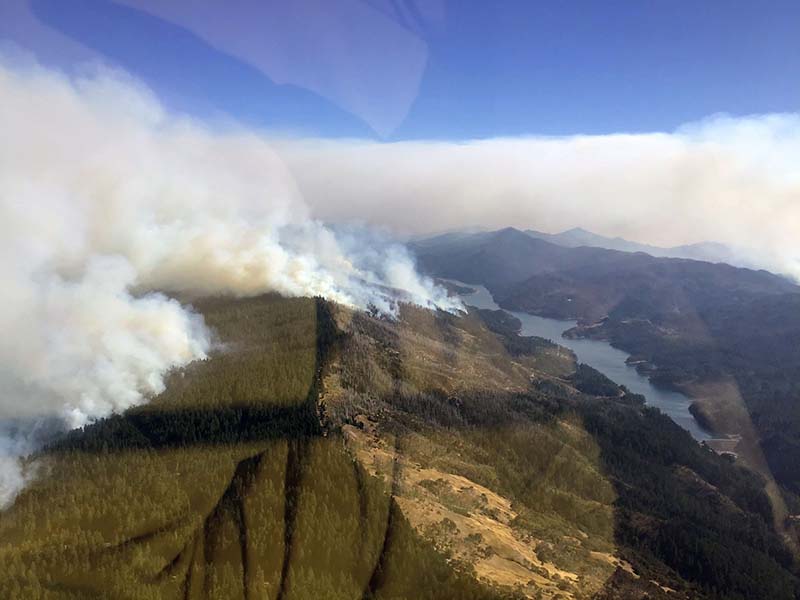When controlled burns go bad
In Evergreen's 40-year history, no topic has commanded more of our attention than wildfire, not even the runup

Editor’s Note: Evergreen colleagues and wildfire experts, Roger Jaegel and James Montgomery have cowritten a thoughtful and penetrating essay in which they ask some long overdue questions concerning the wildfire pandemic the grips the 11 western states.
Although their essay focuses on Ruth, a small northern California town leveled by the 2020 August Complex fire, the scenario they describe could unfold anywhere in the West. In fact, the scenario repeated itself last summer when the 963,000 acre Dixie Fire destroyed Greenville, another small northern California community.
You can watch Mr. Jaegel in action in a very instructive video currently posted on Facebook
Roger Jaegel and James Montgomery
The burning of small towns has become a sort of New Age ritual. Like fair maidens chained as offerings to dragons, small towns of the forest wait in the path of gigantic wildfires, helpless. Like knights errant, valiant firefighters stand between them and the flames. But sometimes the defenders fail. Greenville, Paradise, Grizzly Flats, Concow, Keswick, Magalia, Pulga, Doyle, Detroit, Blue River, Vida, Phoenix, Talent, Elkhorn, Gates, Idanha, Mill City, Lyons, Malden, Canyondam, Bagdad, Los Alamos, Ruth. All burned.
This is the story of Ruth. It is a story filled with questions.
The August Complex was a group of fires resulting from 38 different lightning strikes in Glenn, Lake, Mendocino, Shasta, Tehama and Trinity Counties. Eventually, these fires merged together to become the biggest wildfire in the United States since 1910. This fire was monstrous, with many aspects. The aspect we are looking at concerns the South Fork Mountain and Ruth.
On September 26, 2020, the Forest Service Alaska Incident Team dropped incendiary devices, known as "dragon's eggs," from a helicopter to start fires on South Fork Mountain, in Trinity County. They started fires on Rattlesnake Ridge and other ridges above the small town of Forest Glen. They called this a "defensive burn."
The day after the Alaska Incident Team started their fires, a major "wind incident" occurred. Winds of over 30 miles per hour came roaring in from the northeast and blew these fires up. They burned over South Fork Mountain, across Ruth Lake, and swept over the little community of Ruth.
Ruth is spread out along Ruth Lake. A lake is a pretty good fire break, but the fire jumped the lake, apparently in several places. Some houses were burned, and some, right next door, were spared in a mosaic of destruction.

The thing is, the Forest Service knew the winds were coming. They were predicted several days ahead of time, by the National Weather Service and other weather reports. The USA RAWS Climate Archive for the Mad River Station shows that winds of 33 mph were predicted for September 27, and 38 mph for September 28. So, then, did the decision-makers for the Alaska Incident Team not consult the weather reports? Or did they just not care? They knew a major windstorm was coming!
These are disturbing questions. Many more questions arise:

A Modest Proposal to Save Our Towns
We know how to protect buildings. Defensible space. Rural homeowners are required by law to keep 100 feet of area around their homes cleared of burnable debris. Why not extend this concept to the level of communites?
All areas within a 5 mile radius of specified rural communities should be designated as defensible space. Defensible space is defined as an area cleared of readily flammable materials, such as dry brush, dead and dying trees, too-closely-spaced trees (thickets) and woody debris above the diameter of 3 inches.
The purpose of defensible space is to slow or stop the spread of wildfire, and create an area which can be defended against wildfire. Communities deserve this protection. The goal is to create park-like areas of open fire-resistant timber, green grass, or other fire-resilient vegetation.
The way to achieve this is through thinning and removal of flammable brush, removal of coarse woody debris by mechanical means, prescribed fire when conditions are entirely safe (winter), removal of dead and dying trees (which could be used for lumber), and thinning of closely spaced trees.
The biggest obstacle to achieving defensive space on a community level is interference by the rich and powerful environmental non-profits, whose lawyers use the Endangered Species Act to stop forest management. To protect our towns, we need legislation to amend the ESA to provide for enlightened forest management within the designated areas.
If lawsuits are filed, responsible forest management must be permitted to proceed, pending the outcome of the lawsuit. The stranglehold of the lawyers must be broken, if we intend to save our small towns. On the other hand, maybe we should just let them all burn, to the feed the dragons. After all, dragons are an endangered species, too.
You 100% tax-deductible subscription allows us to continue providing science-based forestry information with the goal of ensuring healthy forests forever.